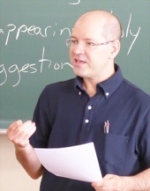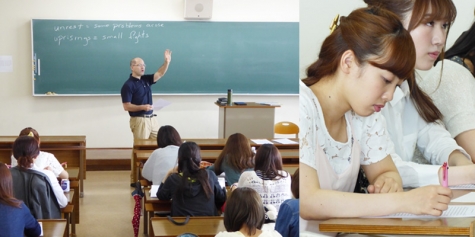
 国際舞台で活躍するためには英語や専門分野の知識に加え、日本の歴史や文化、政治、経済などについての知識も求められます。長年にわたって国際ビジネスや外交交渉にあたってきた方々は皆さん日本の文化や歴史について知っておくことの重要性を強調します。
国際舞台で活躍するためには英語や専門分野の知識に加え、日本の歴史や文化、政治、経済などについての知識も求められます。長年にわたって国際ビジネスや外交交渉にあたってきた方々は皆さん日本の文化や歴史について知っておくことの重要性を強調します。以下は日本の歴史や政治について知り、それを英語で説明できるようになることを主な目的とする「Japan Studies Politics/Historyを担当しているグレゴリー・オキーフ先生(Mr. Gregory J. O’Keefe、米国・ボストン出身)による授業紹介です。
The Japan Studies course was established in 2016. The goal of the course is for students to be able to explain some basic topics of discussion about Japan in English. The instructor chose the topics based on the interests from the western perspective. While Japan offers tourists the chance to read about areas they visit in English, many westerners also want to learn from Japanese people. There are various hurdles Japanese people face when explaining such things in English.
First, they may not even know about the subject in Japanese let alone English. Plus, there are many specialized vocabulary utilized when explaining such topics. Simple wording could be used to get around the barriers of difficult vocabulary, but having the keywords about specific political and historical events will make the explanation all the more valuable to native English speakers. It also creates a strong sense of authenticity to the listener.
This course hopes to give students this power of explanation. The students are first given a reading which covers a topic in either Japanese politics or history. One example would be the political changes that arose after the appearance of Commodore Matthew Perry and the black ships in Edo Bay. Students are asked to read the passage, then the instructor slowly goes through the reading explaining every line as well as necessary keyword vocabulary.
The difficult vocabulary appearing in the reading are usually used to describe specific political or historical events. This helps maintain the authenticity this course hopes to produce. The instructor sometimes uses Japanese to explain difficult concepts then restates the explanation in English so students fully understand what they will be presenting about. This makes the vocabulary powerful and useful for students.
After the instructor finishes explaining the passage, students then ask further questions on vocabulary or sentences they don't understand. After they understand the reading fully, students use the reading as their script for their presentation. They create a powerpoint presentation by compiling pictures and images that best fit the reading. The teacher judges their knowledge by how well their images match the content of the reading. While the actual presentation is only recitation practice, the preparation and presentation skills are also taken into account.
In other classes students prepare their presentations from scratch, which is usually where they put their most effort and time. After writing it, few will practice enough to really improve their presentation ability. By offering the reading as the basis for their presentation they can spend more of their time on preparation rather than writing. All students receive a copy of the reading as well as an audio file of the teacher performing the reading, so they can have an audio example for pronunciation purposes.
The students who prepare through listening to the audio of the reading do extremely well. Furthermore, many of the students create visually pleasing presentations. The bonus from all this work is that students can see how they each perform individually and learn from each other as well. The learning environment for this course is rather unique because of the combination of learning about the politics and history of Japan, while also enhancing presentations and public speaking skills.


学生によるプレゼンテーション、左:Y.Kさん(福岡県立三池高等学校出身)、中:M.Kさん(筑紫女学園高等学校出身)、右N.Tさん(福岡県立嘉穂東高等学校出身)

